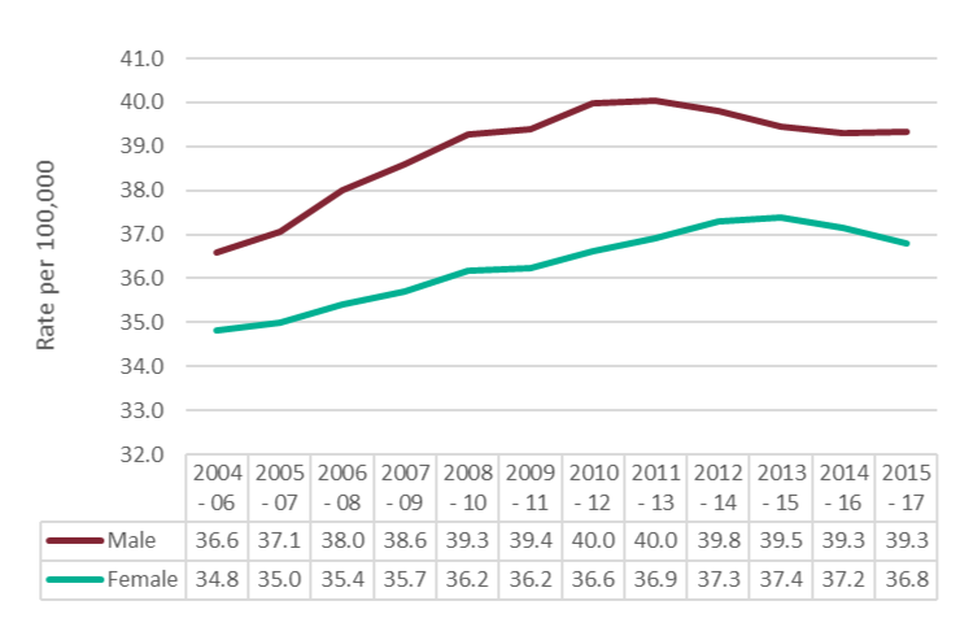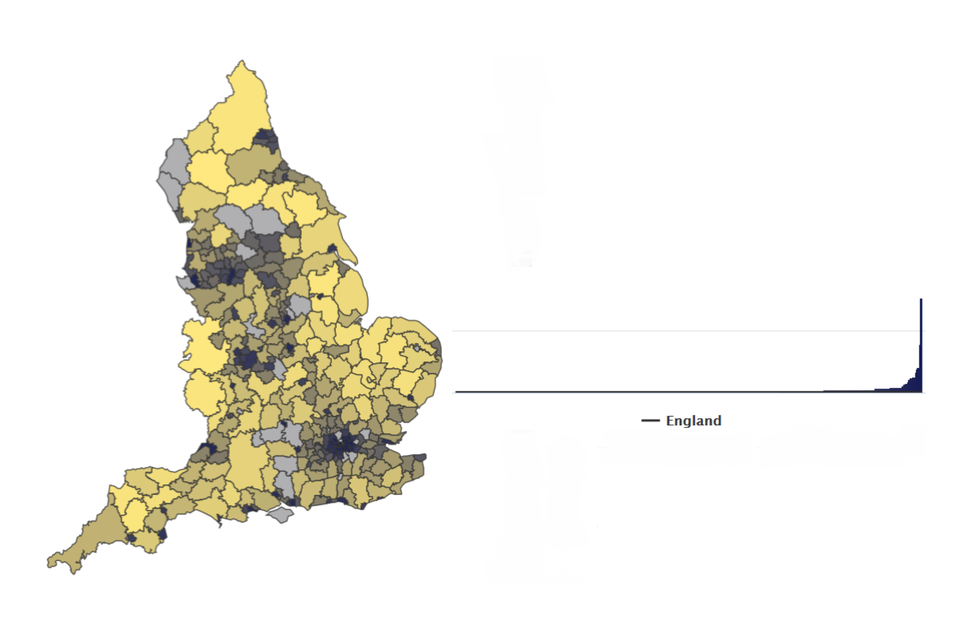Local Alcohol Profiles for England: short statistical commentary, August 2019
Published 6 August 2019
New in this update
New data has been added to the Local Alcohol Profiles for England (LAPE) tool on the Fingertips platform. The following indicators have been updated and are available at Local Authority level as well as for England, the regions, and various inequality groups:
- incidence rate of alcohol-related cancer
- number of premises licensed to sell alcohol per square kilometre
Main findings
- between 2015 to 2017 there were an estimated 58,200 new alcohol-related cancer registrations. This equates to approximately 19,400 new cancer cases each year
- the rate of new alcohol-related cancer has increased gradually between 2004 to 2006 and 2011 to 2013 for both males and females. However, since 2012 to 2014 there have been minor reductions in the incidence rate for both genders
- in 2017 to 2018 there were 164,857 premises across England licensed to sell alcohol
- as we would expect, the density of licensed premises largely mirrors population density, meaning London and the major cities have the greatest number of licensed premises per km²
Key definitions used in this release
Alcohol-related cancer incidence
Alcohol attributable fractions are applied to cancer incidence by age and gender for the 6 cancer types with a recognised link to alcohol consumption:
- lCD-10 codes C00-C14, Lips, oral cavity and pharynx
- ICD-10 code C15, Oesophagus
- ICD-10 code C18-C21, Colorectal
- ICD-10 code C22, Liver
- ICD-10 code C32, Larynx
- ICD-10 code C50, Breast
Number of licensed premises per square kilometre
Number of premises with certificates permitted to sell or supply alcohol on-trade or off-trade per square kilometre. The numerator is published as National Statistics by the Home Office. It is based on administrative data returns from Local Authorities (LAs). However, premises may have a licence to sell alcohol but not actually sell alcohol. Also, premises may have ceased trading since a licence was granted but not yet been removed from LA records.
For a small number of LAs, there are missing or incomplete data and hence LAPE is unable to provide a value for those areas. Correspondingly, the England value is based on LAs with a known number of licensed premises only.
Summary of updated indicators
Alcohol-related cancer incidence
Between 2015 to 2017 there were an estimated 58,200 cancer registrations which were related to alcohol consumption. This equates to approximately 19,400 new cancer cases each year attributed to alcohol.
Figure 1: alcohol-related cancer incidence by gender, England

The rate of alcohol-related cancers in males increased gradually between 2004 to 2006 and 2011 to 2013 and fell in each subsequent period. In the three-year period 2015 to 2017, the rate in males remained static at 39.3 alcohol-related cancers per 100,000 population. The rate of new alcohol-related cancers in females increased each period to 2013 to 2015 but has reduced for the most recent 2 periods and is currently 36.8 per 100,000 population.
Alcohol-related cancer incidence rates are higher for those in the most deprived decile (40.5 per 100,000) compared to the least deprived decile (35.4 per 100,000). For 2015 to 2017, Manchester (49.4 per 100,000) had the highest rate followed by Blackpool (48.8 per 100,000), while Westminster (28.8 per 100,000) had the lowest followed by Kensington and Chelsea (29.6 per 100,000).
Figure 2: alcohol-related cancer incidence, District and UA

Number of premises licensed to sell alcohol per square kilometre
This indicator shows the number of premises with certificates permitted to sell or supply alcohol on-trade or off-trade per square kilometre for each local authority in England. By including this data in LAPE, local authorities can compare the number and density of licensed premises in their area with similar areas and with areas experiencing similar harms.
For 2017 to 2018 there were 164,857 premises across England licensed to sell alcohol. With the exception of Blackpool, the areas with the greatest density of premises were all districts of London, followed by the major cities of Liverpool and Manchester. This is to be expected as we know the density of licensed premises is highly correlated with population density, meaning that there are more premises in areas with more people. This results in a marked variation in the density of licensed premises across the local authorities of England.
Figure 3: number of premises per km², District and UA

Background and further information
The Local Alcohol Profiles for England (LAPE) have been published on an annual basis since 2006. These profiles have been designed to help local government and health services assess the effect of alcohol use on their local populations. They will inform commissioning and planning decisions to tackle alcohol use and improve the health of local communities.
The LAPE data tool helps local areas assess alcohol-related harm and monitor the progress of efforts to reduce this.
View the LAPE Profile.
Definitions and methodology for all LAPE indicators are described in the user guide.
Responsible statistician, product lead: Mark Cook. For queries relating to this publication contact: lape@phe.gov.uk
